
The 7.62x39mm, the official nomenclatured of both CIP and SAAMI standards groups, came into popularity in the U.S. on a wave of inexpensive military surplus SKS and AK47 firearms and caches of military and civilian ammunition of dubious quality. That flow has ebbed, but the cartridge remains, supplying an installed military surplus base, newly minted AK47 derivatives, AR15 derivatives and a number of bolt action sporting rifles. Unfortunately, the cartridge is often hampered by its history.
Factory ammunition, imported and of U.S. manufacturer, is predominately offered in 123 grain bullet form, often assembled with steel casings and Berdan primers. Marketed as soft point hunting ammunition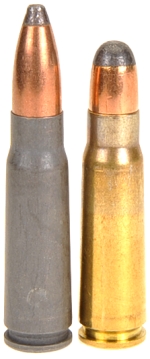 n, it may very well have steel jacketed, copper plated bullets that tend not to expand.
n, it may very well have steel jacketed, copper plated bullets that tend not to expand.
Left – Two types of factory ammo; cheapo steel case Herter’s Berdan primed, 154 grain soft point (Sellier & Bellot) and PPU 123 Grain soft point round nose. There was actually a third, but it did not make it to the picture, Herter’s 123 grain hollow point. Information appears in the range data later in this piece.
The former is made in Russia with a copper plated steel jacketed bullet that tends not to expand in light and medium game. The latter is made in Serbia with a bullet that will at least expand. Neither are marked CIP or SAAMI standards compliance and both represent very inexpensive shooting.
Factory ammunition prices generally range from 22¢ to and eye popping $2.48 per round. Imported steel occupies the low end. The typical for imported brass cased ammunition is 60¢ per round. American brands typically sell near the $1.25 mark. There are currently 25 brands/types for the 7.62x39mm ammunition that are readily available. The top prices are occupied by ego sellers and not one is worth the price.
Seeking opportunity amongst the speed bumps…
For the handloader, SAAMI MAP chamber pressure is capped at 45,000 PSI MAP to suit WW II firearms. This modest pressure ceiling is reflected in mainstream reloading manuals. CIP offers a bit more with a 51,000 PSI Pmax standard. The 7.62x39mm is presented as having power subordinate to the 30-30 WCF. However, while the 7.62x39mm has 9 grains less case capacity than the 30-30 WCF, its CIP Pmax spec is nearly 25% higher making the difference between the two mostly academic.
The 7.62x39mm is truncated with a 2.200″ maximum overall cartridge length, which tends to cause heavy for bore bullets to seat deeply and reduce case net powder capacity. The Ruger’s magazine capacity is 2.300″, which restricts maximum length, even though the rifle’s chamber and throat would allow even greater lengths. The Ruger gives handloaders a bit of latitude.
Contrary to the 7.62x39mm cartridge forward found in most mainstream reloading manuals, Ruger rifles chambered for this cartridge do not have a 0.308″ groove diameter. SAAMI specifies a groove diameter of 0.310″ +0.002″/-0.000″ and bore diameter of 0.300″ +0.002″/-0.000″ . Ruger sets nominal groove diameter at 0.311″ with bore diameter at 0.300″. Checking bullet pulls from factory European ammunition check 0.310″. U.S. cannelured bullets used in handloads appearing here measure 0.310″ to 0.312″, not necessarily in strict harmony with box labels. I have handloaded 7.62x39mm ammo with 0.308″ bullets with substantial success, but they are not correctly dimensioned bullets.
7.62x39mm bullet selection is limited. Bullets 0.310″ is diameter, the size most often called out for the 7.62×39, tend to concentrate around the lower end of the weight spectrum, 108 grains to 125 grains. There are roughly 20 bullet types in broad retail distribution, manufactured by 9 companies. Approximately one third are intended for self defense and paper punching, the rest are constructed for varmint to medium size game hunting. Prices run from 13¢ to $1.34, most in the 20¢ to 30¢ range, with Hornady producing the greatest variety.
There are heavier bullets that fall into the 0.311″ to 0.312″ diameter range, jacketed and cast, that vary significantly in cannelure placement and construction. They are principally designed for the .303 British and 7.7mm Arisaka cartridges, both which have an approximately 400 fps muzzle velocity edge over the 7.62x39mm. How to tell which will expand at 7.62x39mm level velocities? Check with the manufacturer for intended point of impact velocity range or shoot some blocks of ballistic gel to get a sense for their expansion characteristics.
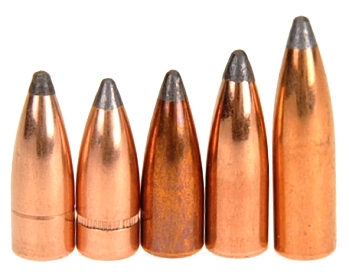
| Bullet | Weight Grains |
Bullet Length “ |
Diameter Listed “ |
Diameter Actual “ |
Listed Application |
Clearance COL “ |
COL” |
| PPU | 123 | 0.898 | 0.3100 | 0.3105 | 7.62x39mm | 2.295 | 2.210 |
| Hornady | 123 | 0.875 | 0.3100 | 0.3100 | 7.62x39mm | 2.266 | 2.200 |
| Sierra Pro-Hunter | 125 | 0.908 | 0.3110 | 0.3115 | 7.62x39mm | 2.320 | 2.185 |
| Speer | 150 | 1.010 | 0.3110 | 0.3120 | 303 British + 7.7 Japanese | 2.290 | 2.275 |
| Sierra Pro-Hunter | 180 | 1.191 | 3.110 | 3.115 | 303 British + 7.7 Japanese | 2.318 | 2.285 |
The 150 grain Speer and 180 grain Sierra have dual taper jackets; thick in the heel, thin over the ogive with vertical striations near the tip to assure expansion in concert with the 7.62x39mm. all of the bullets are flat based to preserve case capacity, which shifts weight to the ogive. So the tradeoff for the flat base is a slightly thickened ogive profile and a slightly reduced ballistic coefficient. Since we are not looking at a 500 yard rifle, I think that is a good compromise.
On the previous table “Clearance COL” = Longest length of cartridge that will chamber with a closed bolt and provides 0.020″ bullet clearance from the rifling leade. This measurement is only taken as a maximum safe length and does not take into consideration cannelure placement, adequate case neck – bullet shank engagement, or magazine length restrictions. Those contingencies are reflected in the “COL” column and on the reloading data table that follows.
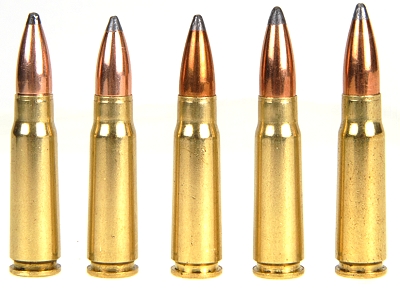
Handloading was uneventful. The brass was new Winchester brass, run through a full length sizer die with a 0.3105″ expander. The Lee Precision die set also includes a 0.308″ expander for use where applicable. All of the handloads were processed through a Lee Precision Factory Crimp die of the collet variety, which pretty much emulates factory stab crimps. One of the manufacturers suggests the world will come to an end if this type of crimp is used where there is no cannelure, however, they are singular in their grievance and I’ve not experienced any problems with this process. Perhaps the complainant might consider what rifling does to a bullet in its routine travels?
I really wanted to use Re 10X across the weight spectrum as it typically generates relatively higher velocity and uniform pressure. Unfortunately, it required more volume than available or excess compression, so Re 7 was used at lower bullet weights. Hodgdon’s CFE-BLK, blended for the 300 AAC Blackout was a good matchup to the 7.62x39mm’s case capacity and bullet weight.
Trail Boss low density powder was used to concoct a number of subsonic loads, one made it to the load sheet, but just as a token “How quiet can it be” experiment.
 |
Warning: Bullet selections are specific, and loads are not valid with substitutions of different bullets of the same weight. Variations in bullet material and length will alter net case capacity, pressure and velocity results. Primer selection is specific and primer types are not interchangeable. These data represents maximum loads in our firearms and test equipment and may easily be excessive in other applications. All loads should be reduced by 3%, and developed following safe handloading practices as represented in established reloading manuals produced by component manufacturers. Presentation of these loads does not constitute a solicitation for their use, nor a recommendation.
|
||||||||||||||||||||||||||||||||||||||||||||||||||||||||||||||||||||||||||||||||||||||||||||||||||||||||||||||||||||||||||||||||||||||||||||||||||||||||||
|
|||||||||||||||||||||||||||||||||||||||||||||||||||||||||||||||||||||||||||||||||||||||||||||||||||||||||||||||||||||||||||||||||||||||||||||||||||||||||||
Assessments
Most reloading manuals suggest that the 7.62x39mm can’t compete with 30-30 WCF ballistics. At CIP pressure levels, there actually isn’t much difference. So why is it you can look up factory ammunition velocity specs for the 30-30 WCF and they are 100 fps – 150 fps greater than the handloading results on the table? Because the standard test barrel length that is used to rate ammunition is 24″ long, compared to the 16.12″ barrel Ruger American Rifle Ranch Thirty, s difference of nearly 8″. Is the velocity difference real? When is the last time you saw a lever action 30-30 WCF with a 24″ barrel? Is the 7.62x39mm right for deer and hogs for the woodland hunter?
| Sierra Pro-Hunter 125 Grain – 237 Yards Point Blank Range | ||||||
| Yards | 0 | 50 | 100 | 150 | 200 | 250 |
| Velocity – fps | 2532 | 2375 | 2224 | 2080 | 1941 | 1807 |
| Energy – ft.-lbs. | 1779 | 1566 | 1373 | 1200 | 1045 | 906 |
| Momentum – lbs-sec | 1.40 | 1.31 | 1.23 | 1.15 | 1.07 | 1.00 |
| Path – in. | -1.5 | 1.5 | 2.9 | 2.6 | 0.2 | -4.4 |
| Speer SP 150 Grain – 219 Yards Point Blank Range | ||||||
| Yards | 0 | 50 | 100 | 150 | 200 | 250 |
| Velocity – fps | 2210 | 2113 | 2019 | 1927 | 1838 | 1752 |
| Energy – ft.-lbs. | 1626 | 1487 | 1357 | 1237 | 1125 | 1022 |
| Momentum – lbs-sec | 1.47 | 1.40 | 1.34 | 1.28 | 1.22 | 1.16 |
| Path – in. | -1.5 | 1.7 | 3.0 | 2.1 | -1.1 | -6.9 |
The answer would have to be yes. Certainly flat shooting enough, with enough retained energy out to over 250 yards and from a very compact, very light and very accurate firearm. I apologize for the spot checks on accuracy, but I just ran out of time. I can say that none of the handloads posted with no specific accuracy data shot as large as an inch.
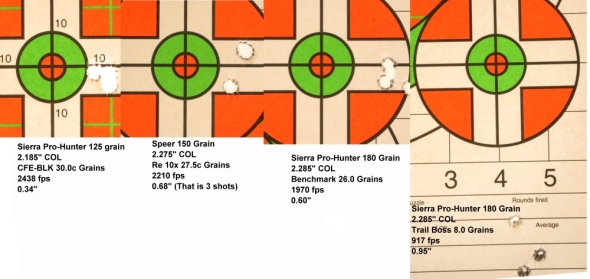
Accuracy with and without silencer demonstrated no more than insignificant differences. The groups above were shot at 100 yards from a rest, suppressed, with a wet washcloth wrapped around the silencer to kill heat wave distortion through the scope. Recoil was of no consequence, report was mild and everything functioned without a hitch. Being picky? I am not a fan of the forward push to release, magazine release as it feels a bit awkward and the magazine feed was a bit rough at times, but that could be the longer than SAAMI 150 grain and 180 grain loads I assembled. Again, being picky.
I think Ruger has a real winner in this Ranch version of the American Rifle. Certainly excellent hunting hardware and certainly with enough choice of cartridges.
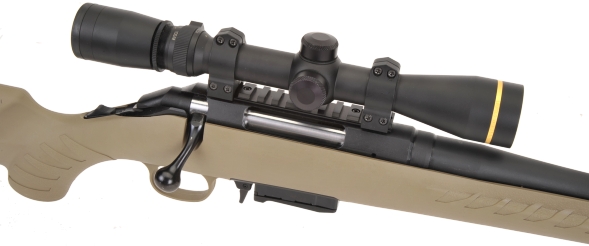

Email Notification